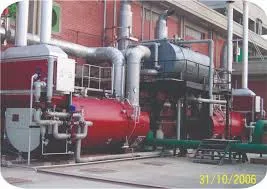Steam Boiler Solutions for AAC Industry Manufacturers and Their Operational Efficiency
The Role of Steam Boilers in the AAC Industry A Focus on Manufacturers
Autoclaved Aerated Concrete (AAC) has revolutionized the construction industry with its lightweight, insulating, and environmentally friendly properties. This innovative building material is produced through a process that requires the precise management of steam, making steam boilers essential for AAC manufacturers. This article explores the significance of steam boilers in the AAC sector, the types available, and what manufacturers should consider when selecting a steam boiler for their operations.
Understanding AAC Production
AAC blocks are made from a mixture of sand, cement, lime, water, and a tiny amount of aluminum powder. The reaction between these components generates hydrogen gas, causing the mixture to expand. The resulting foam is then poured into molds, where it hardens before being cut into blocks. The critical step in this process is autoclaving, wherein the molded blocks are subjected to high-pressure steam for curing. This not only solidifies the blocks but also enhances their strength and thermal insulation properties.
Importance of Steam Boilers in AAC Manufacturing
Steam boilers are vital in the AAC production process for several reasons
1. Consistent Temperature Control In the autoclaving phase, maintaining a consistent temperature and pressure is crucial for the uniformity and quality of AAC blocks. A reliable steam boiler ensures that the right conditions are achieved and maintained throughout the curing process.
2. Energy Efficiency Given the energy-intensive nature of AAC production, using an efficient steam boiler can significantly reduce operational costs. Modern boilers are designed to maximize combustion efficiency and minimize fuel consumption, thereby directly impacting the bottom line.
3. Environmental Compliance With increasing regulations on emissions, AAC manufacturers must select steam boilers that not only comply with local and international standards but also contribute to reducing their carbon footprint. Many manufacturers have begun to invest in advanced boiler technologies that use alternative fuels or incorporate emissions control systems.
4. Operational Reliability A reliable steam boiler minimizes downtime in production. Manufacturers need to ensure that their chosen boiler can withstand the operational demands of an AAC plant, as any failure can lead to significant production losses.
Types of Steam Boilers for AAC Plants
steam boiler for aac industry manufacturers

When it comes to selecting a steam boiler for AAC production, manufacturers typically have a few options
1. Fire-Tube Boilers In this type, hot gases from the combustion process travel through tubes while water surrounds these tubes. Fire-tube boilers are generally simpler and can be a cost-effective choice for smaller AAC plants.
2. Water-Tube Boilers These are designed for higher pressure and efficiency needs. In water-tube boilers, water flows through tubes heated by surrounding hot gases, allowing them to produce steam at higher pressures. These are often preferred for larger AAC manufacturing facilities due to their efficiency and ability to handle higher loads.
3. Biomass Boilers As sustainability becomes more imperative for manufacturers, biomass boilers that use renewable energy sources—such as wood pellets or agricultural waste—are gaining popularity. They not only meet steam requirements but also align with eco-friendly production goals.
Factors to Consider When Choosing a Steam Boiler
1. Capacity and Size The chosen boiler should match the production needs of the AAC plant. An oversized boiler can lead to inefficiencies, while an undersized one may not adequately serve the production demands.
2. Fuel Type The cost and availability of fuels can influence the choice of boiler. Manufacturers should consider both traditional fuels and alternatives to optimize operational costs.
3. Maintenance and Support Reliable maintenance and support from the manufacturer or supplier are essential. Manufacturers should ensure that they can access timely service and parts for their boilers to prevent prolonged downtime.
4. Regulatory Compliance It is crucial to choose a boiler that adheres to local and international emissions regulations. This not only avoids penalties but also contributes to a more sustainable production process.
Conclusion
Steam boilers are a cornerstone of the AAC manufacturing process, playing a critical role in the quality, efficiency, and sustainability of production. Manufacturers must carefully consider their options and select a boiler that fits their specific needs while complying with regulatory standards. By investing in the right boiler technology, AAC manufacturers can ensure enhanced production efficiency, reduced costs, and a better environmental footprint, ultimately positioning themselves as leaders in the evolving construction market.
-
High-Efficiency OEM Steam Boilers w/GPT-4-TurboNewsAug.02,2025
-
Advanced Electric Steam Boiler Manufacturers | GPT-4 Turbo AINewsAug.01,2025
-
Custom Steam Boilers Manufacturer | AI-Enhanced EfficiencyNewsJul.31,2025
-
Top Electric Steam Boiler Makers | AI-OptimizedNewsJul.31,2025
-
Top Electric Steam Boiler Manufacturers - High Efficiency SolutionsNewsJul.30,2025
-
Top Electric Steam Boiler Manufacturers – Efficient Industrial SolutionsNewsJul.29,2025

